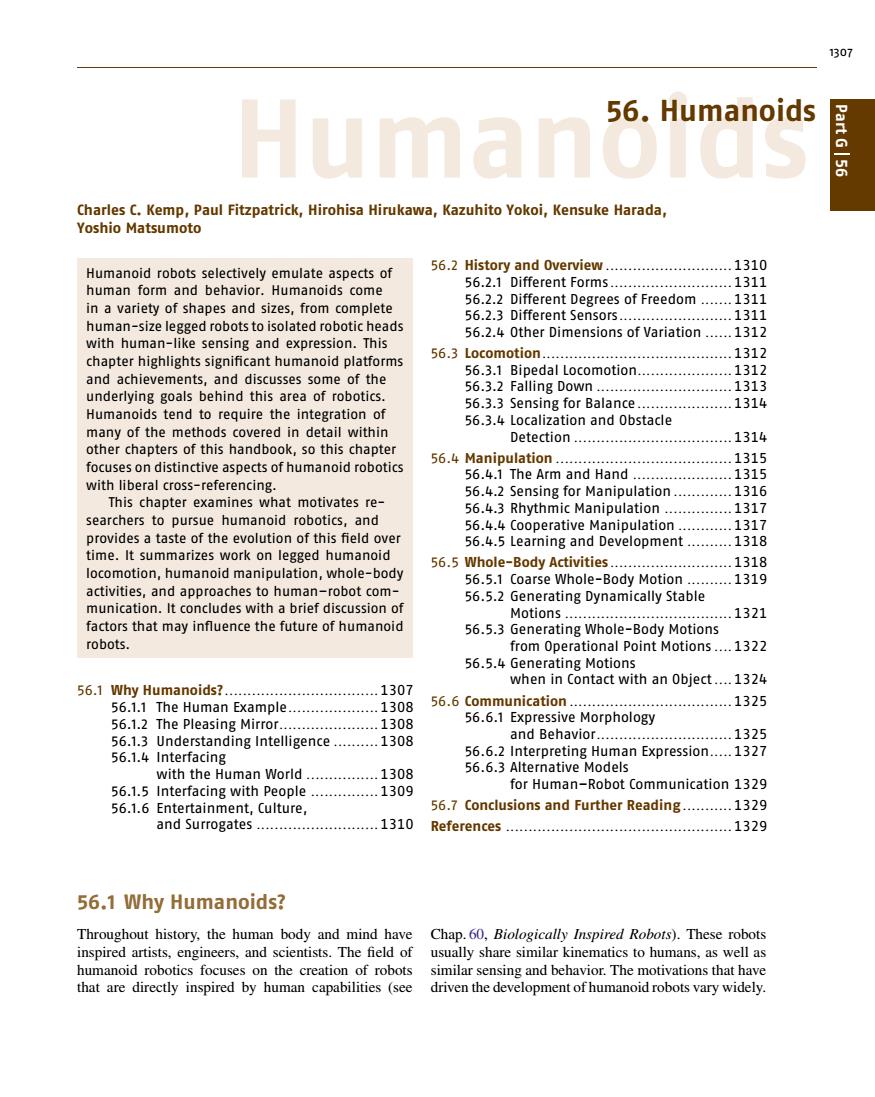正在加载图片...

1307 Humanc us 56,Humanoids Charles C.Kemp,Paul Fitzpatrick,Hirohisa Hirukawa,Kazuhito Yokoi,Kensuke Harada, Yoshio Matsumoto Humanoid robots selectively emulate aspects of 56.2 History and overview...........................1310 human form and behavior.Humanoids come 56.2.1 Different Forms...... 1311 56.2.2 Different Degrees of Freedom ...1311 in a variety of shapes and sizes,from complete 56.2.3 Different Sensors. 1311 human-size legged robots to isolated robotic heads 56.2.4 Other Dimensions of Variation......1312 with human-like sensing and expression.This chapter highlights significant humanoid platforms 56.3L0c0m0ti0n…….1312 56.3.1 Bipedal Locomotion. 1312 and achievements,and discusses some of the 56.3.2 Falling Down............... .1313 underlying goals behind this area of robotics. 56.3.3 Sensing for Balance............ .1314 Humanoids tend to require the integration of 56.3.4 Localization and Obstacle many of the methods covered in detail within Detection.... ..1314 other chapters of this handbook,so this chapter focuses on distinctive aspects of humanoid robotics 56.4 Manipulation..................... 1315 56.4.1 The Arm and Hand 1315 with liberal cross-referencing. 56.4.2 Sensing for Manipulation 1316 This chapter examines what motivates re- 56.4.3 Rhythmic Manipulation ..............1317 searchers to pursue humanoid robotics,and 56.4.4 Cooperative Manipulation 1317 provides a taste of the evolution of this field over 56.4.5 Learning and Development .1318 time.It summarizes work on legged humanoid 56.5 Whole-Body Activities....... .1318 locomotion,humanoid manipulation,whole-body 56.5.1 Coarse Whole-Body Motion 1319 activities,and approaches to human-robot com- 56.5.2 Generating Dynamically Stable munication.It concludes with a brief discussion of Motions..1321 factors that may influence the future of humanoid 56.5.3 Generating Whole-Body Motions robots. from Operational Point Motions....1322 56.5.4 Generating Motions 56.1 Why Humanoids?................. ..1307 when in Contact with an Object....1324 56.1.1 The Human Example ,1308 56.6 Communication.... ...1325 56.1.2 The Pleasing Mirror. .1308 56.6.1 Expressive Morphology 56.1.3 Understanding Intelligence..........1308 and Behavior.................1325 56.1.4 Interfacing 56.6.2 Interpreting Human Expression.....1327 with the Human World .1308 56.6.3 Alternative Models 56.1.5 Interfacing with People...............1309 for Human-Robot Communication 1329 56.1.6 Entertainment,Culture, 56.7 Conclusions and Further Reading....1329 and Surrogates 1310 References ........... 1329 56.1 Why Humanoids? Throughout history,the human body and mind have Chap.60,Biologically Inspired Robots).These robots inspired artists,engineers,and scientists.The field of usually share similar kinematics to humans,as well as humanoid robotics focuses on the creation of robots similar sensing and behavior.The motivations that have that are directly inspired by human capabilities (see driven the development of humanoid robots vary widely.1307 Humanoids 56. Humanoids Charles C. Kemp, Paul Fitzpatrick, Hirohisa Hirukawa, Kazuhito Yokoi, Kensuke Harada, Yoshio Matsumoto Humanoid robots selectively emulate aspects of human form and behavior. Humanoids come in a variety of shapes and sizes, from complete human-size legged robots to isolated robotic heads with human-like sensing and expression. This chapter highlights significant humanoid platforms and achievements, and discusses some of the underlying goals behind this area of robotics. Humanoids tend to require the integration of many of the methods covered in detail within other chapters of this handbook, so this chapter focuses on distinctive aspects of humanoid robotics with liberal cross-referencing. This chapter examines what motivates researchers to pursue humanoid robotics, and provides a taste of the evolution of this field over time. It summarizes work on legged humanoid locomotion, humanoid manipulation, whole-body activities, and approaches to human–robot communication. It concludes with a brief discussion of factors that may influence the future of humanoid robots. 56.1 Why Humanoids? .................................. 1307 56.1.1 The Human Example.................... 1308 56.1.2 The Pleasing Mirror...................... 1308 56.1.3 Understanding Intelligence .......... 1308 56.1.4 Interfacing with the Human World ................ 1308 56.1.5 Interfacing with People ............... 1309 56.1.6 Entertainment, Culture, and Surrogates ........................... 1310 56.2 History and Overview ............................ 1310 56.2.1 Different Forms ........................... 1311 56.2.2 Different Degrees of Freedom ....... 1311 56.2.3 Different Sensors ......................... 1311 56.2.4 Other Dimensions of Variation ...... 1312 56.3 Locomotion.......................................... 1312 56.3.1 Bipedal Locomotion..................... 1312 56.3.2 Falling Down .............................. 1313 56.3.3 Sensing for Balance ..................... 1314 56.3.4 Localization and Obstacle Detection ................................... 1314 56.4 Manipulation ....................................... 1315 56.4.1 The Arm and Hand ...................... 1315 56.4.2 Sensing for Manipulation ............. 1316 56.4.3 Rhythmic Manipulation ............... 1317 56.4.4 Cooperative Manipulation ............ 1317 56.4.5 Learning and Development .......... 1318 56.5 Whole-Body Activities ........................... 1318 56.5.1 Coarse Whole-Body Motion .......... 1319 56.5.2 Generating Dynamically Stable Motions ..................................... 1321 56.5.3 Generating Whole-Body Motions from Operational Point Motions .... 1322 56.5.4 Generating Motions when in Contact with an Object .... 1324 56.6 Communication .................................... 1325 56.6.1 Expressive Morphology and Behavior.............................. 1325 56.6.2 Interpreting Human Expression..... 1327 56.6.3 Alternative Models for Human–Robot Communication 1329 56.7 Conclusions and Further Reading ........... 1329 References .................................................. 1329 56.1 Why Humanoids? Throughout history, the human body and mind have inspired artists, engineers, and scientists. The field of humanoid robotics focuses on the creation of robots that are directly inspired by human capabilities (see Chap. 60, Biologically Inspired Robots). These robots usually share similar kinematics to humans, as well as similar sensing and behavior. The motivations that have driven the development of humanoid robots vary widely. Part G 56